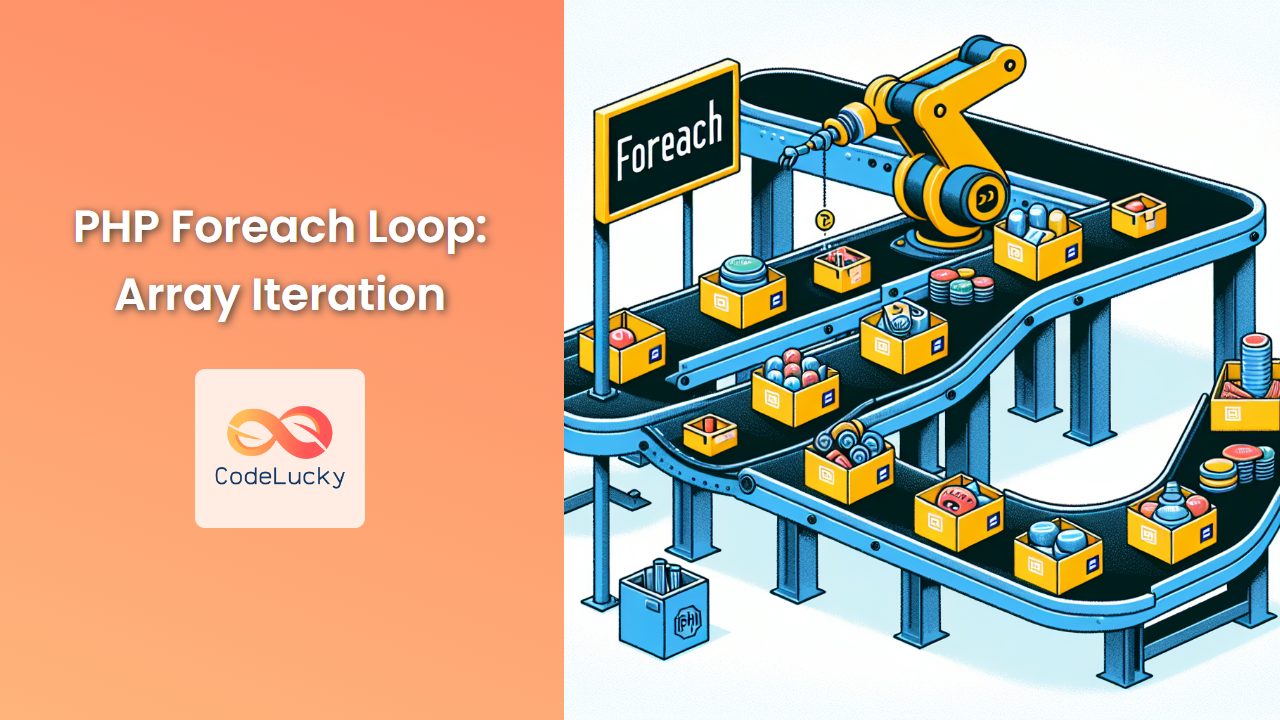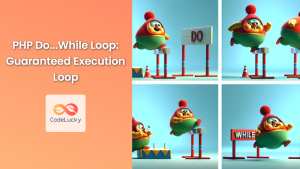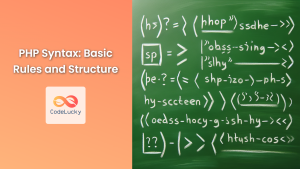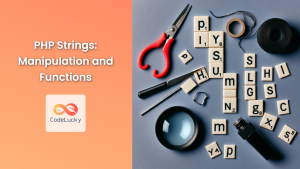PHP’s foreach loop is a powerful tool for iterating through arrays and objects. It’s especially useful when you need to process each element of an array without worrying about the array’s structure or size. In this comprehensive guide, we’ll explore the ins and outs of the foreach loop, providing you with practical examples and best practices to enhance your PHP programming skills.
Understanding the Foreach Loop
The foreach loop in PHP provides a simple and elegant way to iterate over arrays. Its basic syntax is as follows:
foreach ($array as $value) {
// code to be executed
}
For associative arrays, you can also access the key:
foreach ($array as $key => $value) {
// code to be executed
}
Let’s dive into some practical examples to see how foreach can be used in various scenarios.
🚀 Example 1: Iterating Through a Simple Array
Let’s start with a basic example of iterating through a simple indexed array:
<?php
$fruits = ['apple', 'banana', 'cherry', 'date'];
foreach ($fruits as $fruit) {
echo $fruit . "<br>";
}
?>
Output:
apple
banana
cherry
date
In this example, we iterate through the $fruits array, printing each fruit on a new line. The foreach loop automatically assigns each array element to the $fruit variable in each iteration.
🔑 Example 2: Working with Associative Arrays
Foreach loops are particularly useful when working with associative arrays. Let’s look at an example:
<?php
$person = [
'name' => 'John Doe',
'age' => 30,
'profession' => 'Developer',
'city' => 'New York'
];
foreach ($person as $key => $value) {
echo ucfirst($key) . ": " . $value . "<br>";
}
?>
Output:
Name: John Doe
Age: 30
Profession: Developer
City: New York
Here, we use the $key => $value syntax to access both the keys and values of the associative array. The ucfirst() function is used to capitalize the first letter of each key for better presentation.
📊 Example 3: Nested Foreach Loops
Foreach loops can be nested to iterate through multidimensional arrays. Let’s look at an example with a more complex data structure:
<?php
$employees = [
'Development' => [
['name' => 'Alice', 'role' => 'Frontend Developer'],
['name' => 'Bob', 'role' => 'Backend Developer']
],
'Design' => [
['name' => 'Charlie', 'role' => 'UI Designer'],
['name' => 'Diana', 'role' => 'UX Designer']
]
];
foreach ($employees as $department => $members) {
echo "<h3>$department Team:</h3>";
echo "<ul>";
foreach ($members as $member) {
echo "<li>{$member['name']} - {$member['role']}</li>";
}
echo "</ul>";
}
?>
Output:
<h3>Development Team:</h3>
<ul>
<li>Alice - Frontend Developer</li>
<li>Bob - Backend Developer</li>
</ul>
<h3>Design Team:</h3>
<ul>
<li>Charlie - UI Designer</li>
<li>Diana - UX Designer</li>
</ul>
This example demonstrates how to use nested foreach loops to iterate through a multidimensional array, organizing employees by department and role.
🔢 Example 4: Using the Key in Calculations
The foreach loop’s key can be useful in calculations or for generating specific output. Here’s an example:
<?php
$scores = [85, 92, 78, 88, 95];
foreach ($scores as $index => $score) {
$studentNumber = $index + 1;
echo "Student $studentNumber scored $score<br>";
}
?>
Output:
Student 1 scored 85
Student 2 scored 92
Student 3 scored 78
Student 4 scored 88
Student 5 scored 95
In this example, we use the $index to calculate the student number, demonstrating how the key can be utilized within the loop.
🔄 Example 5: Modifying Array Elements
While iterating through an array, you might want to modify its elements. Here’s how you can do that:
<?php
$numbers = [1, 2, 3, 4, 5];
foreach ($numbers as &$number) {
$number *= 2;
}
unset($number); // Unset the reference to avoid accidental modifications
print_r($numbers);
?>
Output:
Array
(
[0] => 2
[1] => 4
[2] => 6
[3] => 8
[4] => 10
)
In this example, we use the & operator to create a reference to each array element, allowing us to modify the original array. Remember to unset the reference variable after the loop to prevent accidental modifications.
🎭 Example 6: Using Foreach with Objects
Foreach loops can also iterate through object properties. Let’s see an example:
<?php
class Person {
public $name;
public $age;
public $city;
public function __construct($name, $age, $city) {
$this->name = $name;
$this->age = $age;
$this->city = $city;
}
}
$john = new Person('John Doe', 30, 'New York');
foreach ($john as $property => $value) {
echo "$property: $value<br>";
}
?>
Output:
name: John Doe
age: 30
city: New York
This example demonstrates how foreach can be used to iterate through the public properties of an object.
🚦 Example 7: Using Break and Continue
The break and continue statements can be used within foreach loops to control the flow of iteration:
<?php
$numbers = [1, 2, 3, 4, 5, 6, 7, 8, 9, 10];
foreach ($numbers as $number) {
if ($number == 5) {
continue; // Skip number 5
}
if ($number > 8) {
break; // Stop the loop when number is greater than 8
}
echo $number . " ";
}
?>
Output:
1 2 3 4 6 7 8
In this example, we skip the number 5 using continue and stop the loop when we reach a number greater than 8 using break.
🔍 Best Practices and Tips
-
Use References Carefully: When using references (
&) to modify array elements, always unset the reference variable after the loop to prevent accidental modifications. -
Avoid Modifying the Array During Iteration: Modifying the array you’re iterating over can lead to unexpected results. If you need to modify the array, consider creating a new array instead.
-
Use Foreach for Readability: Foreach loops are often more readable than traditional for loops when working with arrays, especially associative arrays.
-
Consider Performance: For very large arrays, a traditional for loop might be slightly faster. However, the difference is usually negligible, and foreach is generally preferred for its clarity.
-
Use Array Functions: Sometimes, array functions like
array_map(),array_filter(), orarray_reduce()can be more appropriate than foreach loops for certain operations.
Conclusion
The foreach loop is an essential tool in PHP for working with arrays and objects. Its simplicity and versatility make it a go-to choice for many PHP developers. By mastering foreach loops, you’ll be able to write cleaner, more efficient code when dealing with data structures in PHP.
Remember, practice makes perfect! Try creating your own examples and experiments with foreach loops to deepen your understanding and become more proficient in PHP programming.
Happy coding, and may your loops always terminate! 🚀💻
- Understanding the Foreach Loop
- 🚀 Example 1: Iterating Through a Simple Array
- 🔑 Example 2: Working with Associative Arrays
- 📊 Example 3: Nested Foreach Loops
- 🔢 Example 4: Using the Key in Calculations
- 🔄 Example 5: Modifying Array Elements
- 🎭 Example 6: Using Foreach with Objects
- 🚦 Example 7: Using Break and Continue
- 🔍 Best Practices and Tips
- Conclusion



















